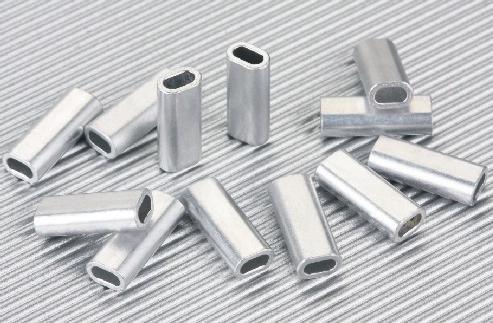Lure Talk, Rigging Talk
Myths About Crimping and Crimp Metals
When it comes to Wahoo Fishing – Cable and wire leaders are a must.
But for offshore fishing in general, there is far too much bad information and outdated myths out there. To top that off, there are size charts for aluminum single sleeve, brass copper double sleeve and everywhere in between. Then, most people talk about mono filament and cable by weight class (eg 150 lbs) but crimps are more commonly rated by line diameter. To continue the confusion, some companies claim their mono filament or fluorocarbon is stronger with the same line diameter. When crimps are rated in diameter vs line diameter it is hard to know which diameter it is, especially for double barrel crimps (eg the diameter of the single or double.) Then Mono is round and 7 strand has grooves, metal densities come into play as well.
Though none of this confusion is likely to go away soon, today I simply want to discuss a myth in the sport fishing (especially wahoo fishing) community that has been spread without thought for many years.
I know that as I write this wahoo fisherman around the globe will read it and likely want to argue, but that is because this myth has been ingrained in our thinking as offshore anglers since we began crimping so many years ago.
The Myth: Don’t use Aluminum Crimps on Stainless Steel Cable or other metal Leaders
Keep reading, and by the end you will understand why this Myth is just that, a Myth.
The Premise Against Aluminum Crimps on Stainless or other Cable: Because they are dissimilar metals there will be greater corrosion which will cause more likely breakage.
True or False? : False There will in fact NOT be more corrosion, it will remain the same, but the galvanic corrosion will be accelerated on one metal while the other metal remains galvanically protected. So true one side of the equation will have more corrosion, but the other side (the important side) is more protected.
Lets Break this Down for Wahoo Fishing Fanatics:
Most people reading this are fisherman. So many of you will be familiar with Anodes. If you are not familiar with the term Anode, but you have a boat, you probably just call them Zincs. Zinc is the most common metal used as an anode because it is the second “least noble or most anodic” on the galvanic scale second only to magnesium, which is for most purposes too highly adodic to use as an anode for saltwater. The Zinc, in essence, steals the corrosion or protects from other more important metallic parts of your boat corroding. This is used in all sorts of industries where corrosion occurs. The anode is the electron or anion attractor to protect (sometimes referred to as cathodic protection) the other metals. Less known is that Aluminum is also used, and for many cases in saltwater and brackish is a better anode than even zinc. In fact, many anodes across industries are aluminum and people just call them zincs, though true the majority of boats use actual zinc.
That’s all great – but how exactly does this relate to fishing?
So now we know another highly anodic or low noble metal is Aluminum. If you have fished long enough, you have probably put an aluminum crimp on stainless cable. You have probably seen the corrosion to the crimp as it certainly will corrode.
So the way this relates to offshore fishing for wahoo, sharks, etc is that most people we interviewed (not in the sport fishing industry by trade but experts in metals and corrosion) believed that aluminum crimps with stainless steel cable would not only be the same as, but in fact likely would last longer while maintaining greater strength of the stainless steel cable than would be true of copper or brass crimps unless those were zinc coated. That is pretty incredible if you think about it. Their reasoning is that the aluminum acts as the anode and keeps all corrosion off of the stainless cable. The aluminum crimp itself will corrode at a greater rate, but for most crimps out there, this would be many years (likely 10 or 20 more if at least rinsed off after) before a crimp would corrode all the way through. The corrosion in fact even bonds the aluminum in some respects – like a Bolt that corrodes can no longer easily be removed and is completely bonded to the other metal it was holding in. When this is considered, plated brass (other than zinc plated) is actually less anodic than even stainless steel. So what does that mean? The corrosion will be more on the stainless than the brass. If this is true the cable will be the one breaking faster, that is crazy. Why do you think most industries use Aluminum or Zinc plated copper on their stainless steel cable Swage or crimp connections? Take corrosion away from the cable, the part that matters. People generally refer to anodes as “Zincs” but the truth is in many cases they are aluminum, and in many cases aluminum is better than zinc as an anode for a variety of reasons. Please do the research if you do not believe me there. You can start here: https://www.fisheriessupply.com/understanding-sacrificial-anodes
So, this post is not only meant to debunk a myth about crimping aluminum to stainless for wahoo fishing, shark fishing, barracuda fishing or fishing in general, but also to help fisherman to be open minded. Lets think for ourselves, learn by experience, and not grab onto an idea that we hear simply because we heard it. Of course it is always wise to listen to others, but do your own research, be open minded, and have fun doing one of the greatest activities in the world. Sport Fishing!

Before writing this article, we consulted with a marine engineer, an aircraft engineer, a heavy equipment mining mechanic, A life-long machinists, and over 100 years of experienced fishermen and woman.
https://en.wikipedia.org/wiki/Galvanic_series#Galvanic_series_(most_noble_at_top)
Personal Fishing Notes:
I have been fishing since I was in diapers, and the only reason I started to see this a long time ago was because I was a charter Captain in Mexico. Crimps were such a pain to acquire and size properly, so we decided to just use aluminum for all our stuff (which is also what all the locals did). It was more available at the time and easier to buy. We caught a lot of Wahoo, so we had to use cable and got tired of trying to have on board so many different crimps. After a year or so, we started seeing that this aluminum bond was not breaking, in fact it even seemed stronger. We also began to notice that the stainless steel cable actually had almost no corrosion on it at all. Ever since then, and this is nearly 20 years ago, I have been using aluminum crimps on my stainless cable and have never had an issue.
We tried to implement this on some of our rigging a few years back but were bad mouthed by some people, so we decided to stick with brass on cable just because the myth was so strong. As a business we understand there will always be misconceptions in any field. And it is not always worth arguing. But, in a recent discussion with an expert in the field, we decided to at least put out another article on our own platform to let people know the important part of the crimp is not the metal used, but the way the crimp is done and sized properly. Of course the metal used does in fact make a difference for other reasons with respect to softness and shape but that is not the topic for this article. This is simply about choosing metal with the consideration of corrosion.
I truly recommend to all wahoo fishermen and woman out there to consider trying out aluminum crimps even on your cable. Honestly, if crimped right, there will be no noticeable difference for years on either, but the only reason I recommend it is to simplify your life. On the contrary, brass on mono is fine as well, but choose one and spend more time fishing and less time finding the right type of metal for your crimps.

